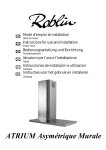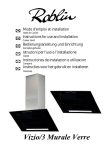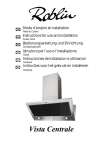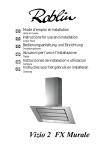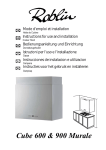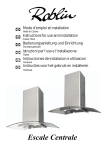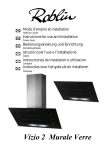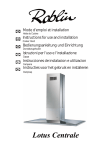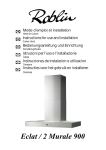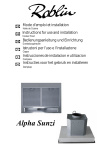Download Evasion/2 Murale
Transcript
FR Mode d’emploi et installation GB Instructions for use and installation DE Bedienungsanleitung und Einrichtung IT Istruzioni per l’uso e l’installazione E Instrucciones de instalacion e utilizacion NL NL Hotte de Cuisine Cooker Hood Dunstabzugshaube Cappa Campana Instructies voor het gebruik en installeren Dampkap Evasion/2 Murale F SOMMAIRE GB CONTENTS RACCORDEMENT ÉLECTRIQUE ELECTRICAL WIRING CONSEILS D’INSTALLATIONS INSTALLATION ADVICE POSE DE L’APPAREIL FITTING THE APPLIANCE FONCTIONNEMENT OPERATION CONSEILS D’UTILISATIONS USEFUL HINTS ENTRETIEN MAINTENANCE GARANTIE ET SERVICE APRÈS-VENTE GUARANTEE AND AFTER-SALES-SERVICES REMARQUES REMARKS D I INHALT CONTENUTI NETZANSCHLUSS COLLEGAMENTO ELETTRICO MONTAGEHILFEN CONSIGLI DI INSTALLAZIONE MONTAGE DES GERÄTES POSA DELL’ APPARECCHIO BETRIEB DES GERÄTES FUNZIONAMENTO NUTZUNG CONSIGLI DI UTILIZZO WARTUNG UND REINIGUNG MANUTENZIONE GARANTIE UND KUNDENDIENST GARANZIA ED ASSISTENZA TECNICA WICHTIGE HINVEISE NOTE E NL SUMARIO INHOUD CONEXION ELECTRICA ELECTRISCHE BEDRADING CONSEJOS DE INSTALACION MONTAGE AANWIJZING INSTALACION DEL APARATO AANSLUITEN VAN HET APPARAAT FUNCIONAMIENTO FUNKTIONEREN CONSEJOS DE UTILIZACION GEBRUIKSADVIES MANTENIMIENTO ONDERHOUD GARANTIA Y ASSISTENCIA TECNICA AFTER SALES SERVICE NOTA OPMERKINGEN F Nous vous remercions de la confiance que vous nous avez accordée en choisissant un appareil de la gamme ROBLIN. Celui-ci a fait l’objet de toute notre attention dans sa conception et sa réalisation. Afin qu’il vous donne entière satisfaction, nous vous recommandons de lire avec attention cette notice qui vous expliquera comment l’installer, l’utiliser et l’entretenir dans les meilleures conditions. La présente notice d’emploi vaut pour plusieurs versions de l’appareil. Elle peut contenir des descriptions d’accessoires ne figurant pas dans votre appareil. 1 RACCORDEMENT ÉLECTRIQUE. • La hotte est équipée d’un cordon d’alimentation de type HO5VVF 3 x 0,75 mm² comportant une fiche normalisée 10/16 A avec système de mise à la terre. Mode de protection : classe I. Tension d’alimentation : 220-240 V mono - 50Hz / 220 V - 60Hz. Vérifier que la tension du secteur est identique aux valeurs indiquées sur la plaque signalétique à l’intérieur de la hotte • Si la hotte est raccordée directement sur le réseau sans sa fiche, un interrupteur omnipolaire avec une ouverture de contact de 3 mm doit être installé avant la hotte. Le fil de terre (Jaune / vert) ne doit pas être interrompu par cet interrupteur. 2 CONSEILS D’INSTALLATION. • Pour un fonctionnement idéal, nous vous conseillons une plage de hauteur de pose qui se situe de 0,65 m à 0,70 m au-dessus du plan de cuisson. Toutefois, il est formellement interdit d’installer toute hotte ou groupe d’aspiration à une distance inférieure à 0,65 m du plan de travail (risque d’inflammation des filtres). La fumée doit monter naturellement vers la zone de captation. • Respecter le diamètre de sortie de l’appareil : la hotte ne doit en aucun cas être raccordée à un conduit de ventilation mécanique contrôlée (V.M.C.). • Lorsqu’on évacue l’air vicié dans un conduit d’évacuation, veiller à ce que celui-ci ne soit pas déjà exploité à véhiculer des gaz ou fumées provenant d’appareils alimentés par une énergie autre qu’électrique. • Positionner le plan de cuisson au plus près de l’évacuation et éviter la formation de coudes sur la gaine, afin de réduire au maximum les pertes de charges. • Dans tous les cas d’installation, veiller au bon renouvellement d’air de la cuisine. Penser à effectuer une ou des entrées d’air par une grille de section égale ou supérieure au diamètre du tuyau d’évacuation, afin de ne pas mettre la cuisine en dépression. • Prévoir une aération suffisante lorsqu’un appareil de cuisson ou autre utilise simultanément l’air ambiant de la pièce où est installée la hotte. • La dépression maximum crée dans la pièce doit être inférieur à 0.04 mbar, ce qui évite un retour de gaz de combustion. • L’appareil doit être positionné de telle façon que la fiche d’alimentation soit accessible. • Cet appareil ne doit pas être utilisé par des personnes (y compris les enfants) ayant des capacités psychiques, sensorielles ou mentales réduites, ni par des personnes n’ayant pas l’expérience et la connaissance de ce type d’appareils, à moins d’être sous le contrôle et la formation de personnes responsables de leur sécurité. 1 F Les enfants doivent être surveillés pour s’assurer qu’ils ne jouent pas avec l’appareil. 3 POSE DE L’APPAREIL. Montage et raccordement doivent être réalisés par un installateur* qualifié. (*) Le non-respect de cette condition entraîne la suppression de la garantie du constructeur et tout recours en cas d’accident. Attention: prendre bien soin d’employer les chevilles adaptées au support, se renseigner au près des fabricants, effectuer un scellement si nécessaire. La société décline toute responsabilité en cas d’accrochage défectueux dû au perçage et chevillage. 1) Tracer sur la paroi une verticale jusqu’au plafond à l’emplacement de la hotte au centre de la zone prévue pour le montage de la hotte (Fig.1 & 2, rep. 1). Cette ligne sert pour aligner verticalement les différentes parties. 2) Positionner le support de conduit (Fig. 1 & 2, Rep. 2), centré sur la verticale à 1 à 2 mm du plafond ou de la limite supérieure et marquer sur la paroi les deux alésages du support. Effectuer sur la paroi deux trous avec un foret Ø 8 mm. Fixer le support de conduit (Rep. 2) à l’aide des vis (12a) 4.2 x 44,4 et des chevilles fournies.Puis positionner et fixer comme indiqué Fig. 2 le second support (Rep. 2) pour une hauteur standard de haut de conduit de 620 mm. 3) Définir la position des trous de fixation Fig. 1 & 2, Rep. 1: Marquer un point sur la ligne verticale à une distance du plan de cuisson de : d = 632�mm (mesure sans crédence). d = hauteur crédence + 3.2 mm (mesure avec crédence). La hauteur H est la hauteur minimum en mm du plan de cuisson au bas de la hotte (Rep. 3). Tracer sur le point marqué une ligne horizontale parallèle au plan de cuisson. Effectuer sur la paroi les deux trous 1 avec un foret Ø 8 mm . Insérer les chevilles et visser les vis 4.2 x 44,4 fournies en laissant un espace de 5-6 mm nécessaire pour l’accrochage du corps de la hotte (Fig. 3a). Il sera possible d’effectuer de petits ajustages au moyen des vis de réglage de la hotte (Voir Montage du corps de la hotte). La hotte peut avoir une excursion maximum de 16 mm. Crédence (Option) : La hauteur de la hotte par rapport au plan de cuisson est déterminée, dans ce cas par la hauteur de la crédence Rep B et par l’éventuel dosseret du plan de travail. La crédence doit être montée avant le corps de la hotte et si l’on désire la fixer contre le mur tant en haut qu’en bas, il est nécessaire de la positionner à la juste hauteur. Etant donné qu’il s’agit d’une opération compliquée, elle doit être effectuée exclusivement par l’installateur de la cuisine ou par du personnel compétent connaissant toutes les dimensions finales des meubles. 4) Montage du corps de la hotte : Avant d’entreprendre l’installation, il est nécessaire de régler les étriers du support en tournant dans le sens des aiguilles d’une montre les vis de réglage Vr jusqu’en fin de course (Fig. 3b). Accrocher le corps (Rep. 5) sur les deux vis 1 précédemment installées (Fig. 3a). Mettre la hotte de niveau en tournant les vis de réglage Vr et compléter le serrage des vis 1. 5) Raccordement • Pour la version Evacuation Extérieure : a- Mettre en place le clapet anti-retour (Rep. 8) sur la sortie de l'appareil (Rep. 6) et raccorder le tuyau flexible (Fig. 5) à l’évacuation extérieure et la sortie de l’appareil (Rep. 6). Fixer l’ensemble à l’aide de colliers ou de ruban adhésif appropriés. b- Enlever les filtres à graisse et s'assurer que le connecteur du cable d'alimentation soit bien branché dans la prise du moteur (Fig. 4).Raccorder électriquement la hotte (Voir paragraphe Raccordement Electrique) et vérifier le bon fonctionnement de l’éclairage, du moteur et du changement des vitesses d’aspiration. c- Conduit supérieur : Elargir légèrement les 2 bords latéraux (Fig.5, Rep. 7a) et les accrocher derrière les support (Rep. 2), refermer jusqu'à la butée. Fixer latéralement au support (Rep. 2) à l'aide des 2 vis (12c) 2.9 x 9.5 fournies. d- Conduit inférieur : Elargir légèrement les 2 bords latéraux (Fig.5, Rep. 7b) et les accrocher entre le conduit supérieur et la paroi; refermer jusqu'à la butée. fixer latéralement la partie inférieur au corps de la hotte à l'aide des 2 vis (12c) 2.9 x 9.5 fournies. • Pour la version Recyclage: 2 F a- Fixer le support (Rep.4) du déflecteur sur la fixation du haut de conduit, le déflecteur est fixé avec les mêmes vis que le support de haut de conduit (Fig.7, rep. 2). Inserer latéralement les rallonges raccord (Rep.G) sur le déflecteur (Rep. R). S'assurer que la sortie des rallonges raccord se trouve au niveau des ouies du conduit aussi bien en horizontal qu'en vertical. b- Installer un tuyau de diamètre approprié (Non fourni) entre la sortie de l’appareil et à l’entrée du déflecteur. Fixer l’ensemble à l’aide de colliers ou de ruban adhésif appropriés. c- Enlever les filtres à graisse et s'assurer que le connecteur du cable d'alimentation soit bien branché dans la prise du moteur (Fig. 4). Raccorder électriquement la hotte (Voir paragraphe Raccordement Electrique) et vérifier le bon fonctionnement de l’éclairage, du moteur et du changement des vitesses d’aspiration. d- Enlever les filtres métalliques et placer la cartouches à charbon actif dans son logement en exerçant une pression sur les languettes A (Fig. 8). e- Conduit supérieur : Elargir légèrement les 2 bords latéraux (Fig.7, Rep. 7a) et les accrocher derrière les support (Rep. 2), refermer jusqu'à la butée. Fixer latéralement au support (Rep. 2) à l'aide des 2vis (12c) 2.9 x 9.5 fournies. f- Conduit inférieur : Elargir légèrement les 2 bords latéraux (Fig.7, Rep. 7b) et les accrocher entre le conduit supérieur et la paroi; refermer jusqu'à la butée. 3 F 4 4 FONCTIONNEMENT F 5 CONSEILS D’UTILISATION. • Pour obtenir une efficacité maximum d’absorption des fumées ou des vapeurs, faire fonctionner l’appareil 5 minutes environ avant et après la cuisson des aliments; La première vitesse est conseillée pour les cuissons à feu doux et pour les sauces. La deuxième pour les cuissons soutenues, grillades et friteuses. La troisième est indiquée pour les cuissons à forte émanation de graisses et vapeur. • IMPORTANT . NE JAMAIS FLAMBER DE METS AU DESSOUS DE L’APPAREIL Ne laissez jamais de flammes libres sous la hotte en fonctionnement. • 6 Les fritures nécessitent une surveillance permanente, l’huile surchauffée pouvant s’enflammer. ENTRETIEN. Déconnecter le câble d’alimentation pour toute intervention électrique. L’appareil a été conçu pour faciliter au maximum les opérations d’entretien, synonyme de bon fonctionnement et rendement de l’appareil dans le temps. • Nettoyage des filtres métalliques. Il est indispensable de procéder à un NETTOYAGE PÉRIODIQUE de ces filtres à la main (avec un détergent liquide à l’eau tiède et rinçage) ou au lave- vaisselle (tous les deux mois environ pour une utilisation normale). • Carrosserie. Nettoyer régulièrement celle-ci en utilisant des produits détergents, non abrasifs et une éponge légèrement humide. N’utilisez jamais d’éponges ou de chiffons trempés N’introduisez aucun objet, ni les mains dans l’ouverture servant à l’évacuation de l’air • Conduit d’évacuation. Vérifier tous les 6 mois le bon écoulement de l’air vicié. Observer les prescriptions réglementaires locales concernant l’évacuation de l’air vicié. • Éclairage. Avant toute intervention sur l’appareil, mettre l’interrupteur d’allumage des lampes en position éteinte. Ne pas dépasser la puissance prescrite et ne pas changer de type de lampe. 7 GARANTIE ET SERVICE APRÈS-VENTE. • En cas d’anomalie de fonctionnement, prévenez votre installateur qui devra vérifier l’appareil et son raccordement. • Dans le cas où un composant électrique viendrait à être endommagé, celui-ci ne peut être remplacé que par un atelier de réparation reconnu par le fabricant, car des outils spéciaux sont nécessaires. • Débrancher complètement l’appareil. • Exigez toujours l’utilisation de pièces de rechange d’origine. La non observation de cette prescription peut compromettre la sécurité de l’appareil. • Lors de la commande de pièces détachées, rappeler le numéro de l’appareil inscrit sur la plaque signalétique située à l’intérieur de la hotte. • Seule la facture d’achat de l’appareil fera foi pour l’application de la garantie contractuelle. Cette garantie ne couvre pas les consommables comme : - L’éclairage : lampes incandescentes, halogènes ... - Les filtres. 8 REMARQUES. Cet équipement est conforme à la norme européenne sur la basse tension 2006/95/CE relative à la sécurité électrique et aux normes européennes: 2004/108/CE relative à la compatibilité électromagnétique 5 F et 93/68 relative au marquage CE. Lorsque ce symbole d’une poubelle à roue barrée est attaché à un produit, cela signifie que le produit est couvert par la Directive Européenne 2002/96/EC. Votre produit est conçu et fabriqué avec des matériaux et des composants de haute qualité, qui peuvent être recyclés et utilisés de nouveau. Veuillez vous informer du système local de séparation des déchets électriques et électroniques. Veuillez agir selon les règles locales et ne pas jeter vos produits usagés avec les déchets domestiques usuels. Jeter correctement votre produit usagé aidera à prévenir les conséquences négatives potentielles contre l’environnement et la santé humaine. 6 GB Thank you for buying a ROBLIN product which has been manufactured to the highest quality standards to meet your requirements. We recommend you carefully read this booklet in which you will find instructions for installation, hints for use and maintenance. The Instructions for Use apply to several versions of this appliance. Accordingly, you may find descriptions of individual features that do not apply to your specific appliance. 1 ELECTRICAL • This cooker hood is fitted with a 3-core mains cable with a standard 10/16A earthed plug. • Alternatively the hood can be connected to the mains supply via a double-pole switch having 3mm minimum contact gap on each pole. • Before connecting to the mains supply ensure that the mains voltage corresponds to the voltage on the rating plate inside the cooker hood. • Technical Specification: Voltage 220-240 V, single phase ~ 50 Hz / 220 V - 60Hz. 2 INSTALLATION ADVICE • Ensure the cooker hood is fitted in compliance with the recommended fixing heights. • To ensure the safe operation of this cooker hood, we recommend that the hood should not be fitted below 65cm (for electric) or (70cm for gas) the measurements taken from the surface of the cooking appliance to the underside of the cooker hood. • It is a possible fire risk if the hood is not sited as recommended. • To ensure the best results, the cooking fumes should be able to rise naturally towards the inlet grilles on the underside of the cooker hood and the cooker hood should be positioned away from doors and windows, which will create turbulence. • Ducting • If the room where the hood is to be used contains a fuel-burning appliance such as a central heating boiler then its flue must be of the room sealed or balanced flue type. • If other types of flue or appliances are fitted ensure that there is an adequate supply of fresh air to the room. Ensure the kitchen is fitted with an airbrick, which should have a cross-sectional measurement equivalent to the diameter of the ducting being fitted, if not larger. • The ducting system for this cooker hood must not be connected to any existing ventilation system, which is being used for any other purposes or to a mechanically controlled ventilation ducting. • The ducting used must be made from fire retardant materials and the correct diameter must be used, as incorrect sized ducting will affect the performance of this cooker hood. • When the cooker hood is used in conjunction with other appliances supplied with energy other than electricity, the negative pressure in the room must not exceed 0.04 mbar to prevent the fumes from combustion being drawn back into the room. • The appliance is for domestic use only and should not be operated by children or people who are infirm without supervision. • This appliance must be positioned so that the wall socket is accessible. • This appliance is not intended for use by persons (including children) with reduced physical, sensory or mental capabilities, or lack of experience and knowledge, unless they have been given supervision or instruction concerning use of the appliance by a person responsible for their safety. Children should be supervised to ensure that they do not play with the appliance. 3 FITTING Any permanent electrical installation must comply with the latest regulations concerning this type of installation and a qualified electrician must carry out the work. Non-compliance could cause serious accidents or injury and would deem the manufacturers guarantee null and void. IMPORTANT - The wires in this mains lead are coloured in accordance with the following code : 7 GB green / yellow : earth blue : neutral brown : live As the colours of the wires in the mains lead of this appliance may not correspond with the coloured markings identifying the terminals in your plug, proceed as follows. - The wire which is coloured green and yellow must be connected to the terminal in the plug which is or coloured green or green and yellow. marked with the letter E or by the earth symbol - The wire which is coloured blue must be connected to the terminal which is marked with the letter N or coloured black. - The wire which is coloured brown must be connected to the terminal which is marked with the letter L or coloured red. ATTENTION: Do not forget to use adequate plugs to the support brackets. Enquire after the manufacturers. Do an embedding if necessary. The manufacturer accepts no responsibility in case of a faulty hanging due to the drilling and the setting up of plugs. 1) Draw a vertical line onto the wall from the centre of the cooking appliance up to the ceilling, using a spirit level and a marker pen as illustrated in Fig. 1 & 2 - item 1. This is to ensure the correct alignment of the chimney hood. 2) Place one of the brackets item 2 on the wall about 1 or 2 mm from the ceiling or from the upper limit, aligning its centre (notches) on the vertical line. Mark the two eyelet holes of the bracket onto the wall. Place the other bracket item 2 on the wall, aligning it with the vertical line, at a distance X=620 mm measured as in Fig. 2 equal to the height of the upper chimney stack item 7a provided with the hood. The X measurement may have different values, according to the available heights of the upper chimney stack. Drill the holes for the 2 fixing brackets using an 8 mm masonry bit. Fix the chimney brackets item 2 using the 4.2 x 44.4 mm screws and rawl plugs supplied. 3) Drilling fixing holes 1 (Fig. 1 & 2): Mark a point on the vertical line at a distance from the cooking appliances of: d = 965 mm (Measurement without splashback). d = height of the splashback + 315 mm (Measurement with splashback). The distance H is the minimum height in mm from the cooking appliances to the bottom edge item 3 of the front panel of the hood. At the point marked, draw a horizontal line parallel to the cooking appliances. Drill two holes 1 in the wall using an 8 mm drill bit and insert the rawl plugs and screws into the holes 1 (4.2 x 44.4 screws). Fix the screws, leaving a space of 5-6 mm required to hook up the canopy (Fig. 3a). Small adjustments can be made using the hood adjustment screws (see Fitting the canopy). The hood should have a maximum excursion of 16 mm. Splashback (optional): When a splashback is to be fitted, the distance between the hood and the cooking appliances will be determined by the height of the splashback item B and whether or not there is a raised back on the worktop. The splashback is to be installed before installing the canopy. If the splashback is to be fixed to the wall using both the top and bottom fixing holes, Care must be taken to ensure that the splashback is fitted at the correct height before fixing the base units or at least the worktop covering them. As this is a complex operation, it should only be undertaken by the technician installing the kitchen units or by a competent person who knows the final dimensions of the units. 4) Fixing the canopy: Before starting to fix the canopy it will be necessary to adjust the support brackets by turning the adjustment screws Vr in a clockwise direction until their reach their limit (Fig.3b). Hook the canopy onto the two size 4.2 x 44.4 screws 1 fitted as described above (Fig.3a). Level the hood by turning the adjustment screws and then locking the screws 1. 5) Ducting: The hood is more effective when used in the extraction mode (ducted to the outside). When the cooker hood is ducted to the outside, charcoal filters are not required.The ducting used must be 150 mm (6 INS), rigid circular pipe and must be manufactured from fire retardant material, produced to BS.476 or DIN 4102-B1. Wherever possible use rigid circular pipe which has a smooth interior, rather than the expanding concertina type ducting. Maximum length of ducting run: 8 GB - 4 metres with 1 x 90° bend. - 3 metres with 2 x 90° bends. - 2 metres with 3 x 90° bends. The above assumes our 150 mm (6 INS) ducting is being installed. Please note ducting components and ducting kits are optional accessories and have to be ordered, they are not automatically supplied with the chimney hood. IN THE EXTRACTION MODE: a. Place the anti-backflow flats item 8 over the round outlet item 6 and connect the ducting 150mm (6 INS) over the round outlet item 6 on top of the canopy and secure the connections with appropriate clamping rings or adhesive tape (Fig. 5). b. Remove the grease filters (see paragraph Maintenance) being sure that the connector of the mains cable is correctly inserted in the socket placed on the side of the fan. Before fitting the chimney to the canopy make the electrical connection as described in the section titled ELECTRICAL. When the electrical connection has been made, test the lights and the fan motor. c. Upper chimney stack •Slightly widen the two sides of the upper chimney stack (Fig.5 - Item 7a) and hook them behind the brackets item 2 making sure that they are well seated. •Secure the sides to the upper bracket using the 2 screws 12c (2,9 x 9,5) supplied. d. Lower chimney stack •Slightly widen the two sides of the chimney stack (Fig. 5 - Item 7b) and hook them between the upper chimey stack and the wall, making sure that they are well seated. IN THE RECIRCULATION MODE: a. Fit the recirculation spigot bracket item 4 onto the upper chimney wall bracket using the same fixing screws (Fig.7 - item 2). Put the spigot item R into the spigot bracket item 4• Insert the connection extension pieces laterally item G in the spigot. Make sure that the outlet of the extension pieces item G is horizontally and vertically aligned with the chimney outlets. b. Connect the ducting 150mm (6 INS) not provided between motors item 6 and the recirculation spigot and secure the connections with appropriate clamping rings or adhesive tape. c. Remove the grease filters (see paragraph Maintenance) being sure that the connector of the feeding cable is correctly inserted in the socket placed on the side of the fan. Before fitting the chimney to the canopy make the electrical connection as described in the section titled ELECTRICAL. When the electrical connection has been made, test the lights and the fan motor. d. Remove the metal grease filters and insert the charcoal filter into the base of the motor housing and secure the filter with two metal securing straps item A as illustrated in Fig. 8. e. Upper chimney stack •Slightly widen the two sides of the upper chimney stack (Fig.7 - Item 7a) and hook them behind the brackets item 2 making sure that they are well seated. •Secure the sides to the upper bracket using the 2 screws 12c (2,9 x 9,5) supplied. f. Lower chimney stack •Slightly widen the two sides of the chimney stack (Fig. 7 - Item 7b) and hook them between the upper chimey stack and the wall, making sure that they are well seated. 9 GB 4 10 OPERATION GB 5 USEFUL HINTS • To obtain the best performance we recommend you to switch ‘ON’ the cooker hood a few minutes (in the boost setting) before you start cooking and you should leave it running for approximately 15 minutes after finishing. • IMPORTANT: NEVER DO FLAMBÉ COOKING UNDER THIS COOKER HOOD • Do not leave frying pans unattended during use as over-heated fat and oil might catch fire. • Do not leave naked flames under this cooker hood. • Switch ‘OFF’ the electric and gas before removing pots and pans. • Ensure heating areas on your hotplate are covered with pots and pans when using the hotplate and cooker hood simultaneously. 6 MAINTENANCE Before carrying out any maintenance or cleaning isolate the cooker hood from the mains supply. The cooker hood must be kept clean; a build up of fat or grease may cause a fire hazard. Casing • Wipe the cooker hood frequently with a clean cloth, which has been immersed in warm water containing a mild detergent and wrung out. • Never use excessive amounts of water when cleaning particularly around the control panel. • Never use scouring pads or abrasive cleaners. • Always wear protective gloves when cleaning the cooker hood. Metal Grease Filters : The metal grease filters absorb grease and dust during cooking in order to keep clean the cooker hood inside. The grease filters should be cleaned once a month or more frequently if the hood is used for more than 3 hours per day. To remove and replace the metal grease filters • Remove the metal grease filters one at a time by releasing the catches on the filters; the filters can now be removed. • The metal grease filters should be washed, by hand, in mild soapy water or in a dishwasher. • Allow to dry before replacing. Active Charcoal Filter : The charcoal filter cannot be cleaned. The filter should be replaced at least every three months or more frequently if the hood is used for more than three hours per day. To remove and replace the filter • Remove the metal grease filters. • Press against the two retaining clips, which hold the charcoal filter in place and this will allow the filter to drop down and be removed. • Clean the surrounding area and metal grease filters as directed above. • Insert the replacement filter and ensure the two retaining clips are correctly located. • Replace the metal grease filters. Extraction tube : Check every 6 months that the dirty air is being extracted correctly. Comply with local rules and regulations with regard to the extraction of ventilated air. Lighting : If the lamp fails to function check to ensure it is fitted correctly into the holder. If lamp failure has occurred then it should be replaced with identical replacement. Do not replace with any other type of lamp and do not fit a lamp with a higher rating. 7 GUARANTEE AND AFTER SALES SERVICE • In the event of any malfunction or anomaly, notify your fitter who will have to check the appliance and its connection. 11 GB • In the event of damage to the mains supply cable, this can only be replaced by at approved repair centre appointed by the manufacturer who will have the required tools and equipment to carry out any repairs properly. Repairs carried out by other persons will invalidate the guarantee. • Use only genuine spare parts. Should these warnings fail to be observed it could affect the safety of your cooker hood. • When ordering spare parts quote the model number and serial number written on the rating plate, which is found on the casing behind the grease filters inside the hood. • Proof of purchase will be required when requesting service. Therefore, please have your receipt available when requesting service as this constitutes the date from which your guarantee commenced. This Guarantee does not cover : - Damage or calls resulting from transportation, improper use or neglect, the replacement of any light bulbs or filters or removable parts of glass or plastic. These items are considered to be consumable under the terms of this guarantee. 8 REMARKS This appliance complies with European regulations on low voltages Directive 2006/95/CE on electrical safety, and with the following European regulations: Directive 2004/108/CE on electromagnetic compatibility and Directive 93/68 on EC marking. When this crossed-out wheeled bin symbol is attached to a product it means the product is covered by the European directive 2002/96/EC.Your product is designed and manufactured with high quality materials and components, which can be recycled and reused.Please inform yourself about the local separate collection system for electrical and electronic product. Please act according to your local rules and do not dispose of your old products with your normal household waste. The correct disposal of your old product will help prevent potential negative consequences for the environment and human health. 12 A1 UK ELECTRICAL CONNECTION The wires in this mains lead are coloured in accordance with the following code: ELECTRICAL REQUIREMENTS Any permanent electrical installation must comply with the latest I.E.E. Regulations and local Electricity Board regulations. For your own safety this should be undertaken by a qualified electrician e.g. your local Electricity Board, or a contractor who is on the roll of the National Inspection Council for Electrical Installation Contracting (NICEIC). ELECTRICAL CONNECTION Before connecting to the mains supply ensure that the mains voltage corresponds to the voltage on the rating plate inside the cooker hood. This appliance is fitted with a 2 core mains cable and must be permanently connected to the electricity supply via a double-pole switch having 3mm minimum contact gap on each pole. A Switched Fuse Connection Unit to BS.1363 Part 4, fitted with a 3 Amp fuse, is a recommended mains supply connection accessory to ensure compliance with the Safety Requirements applicable to fixed wiring instructions. Green & Yellow CH Fiche de sécurité class 1, 250 V~ 10A 2 poles + terre. Stecker der Schutzklasse 1, 250 V~ 10A Zweipolig mit Schutzkontakt (Erde). Spira di sicurezza classe 1, 250 V~ 10A 2 poli + terra SEV 1011, SN416534-2, CH-Typ 12 A2 Earth Blue Neutral Brown Live As the colours of the wires in the mains lead of this appliance may not correspond with the coloured markings identifying the terminals in your connection unit, proceed as follows:The wire which is coloured blue must be connected to the terminal which is marked with the letter ‘N’ or coloured black. The wire which is coloured brown must be connected to the terminal which is marked with the letter ‘L’ or coloured red. 6,3 µF 415 V 275 W 220 - 240V 50Hz A - AZUR - AZUR - AZUR BLAU BK - BLACK - NOIR- SCHWARZ B - BLUE - BLEU - BLAU Br - BROWN - BRUN - BRAUN G-Y - GREEN YELLOW - VERT JAUNE - GRÜN GELB Gr - GREY - GRIS - GRAU L B - LIGHT BLUE - BLEU CLAIR - HELL BLAU P - PINK - ROSE - ROSA V - PURPLE - MAUVE - MALVER FARBIG R - RED - ROUGE - ROT W - WHITE - BLANC - WEISS W-P - WHITE PINK - BLANC ROSE - WEISS ROSA Y - YELLOW - JAUNE - GELB Evasion depuis : Janvier 2013 (From) 3S_Evasion_M_90_V2013-01 MAJ (UPDATE) : 12/12/ 20 Page 1/1 A4 265 63 400 41 37 456 30 min:675/Max:1025 108 Ø150 650 min 81 110 496 314 303 700 898 126 16 7a 7b 1 115 315 2 232 965 H mini. 650 mm 1 1 2 6 1 5 3 2 2 1 A5 3 12a + + + 3a Vr Vr 3b A6 4 5 7a 7b A7 Halogen Beleuchtung Halogen Lighting Eclairage halogène Alogene Luci Alógenas Luz Halogeen Verlichting 2 x 20 W - 12 V G4 12V 20W A8 6 2 965 115 4 G 7a R 7b 7 A A9 ACCESSOIRES ACCESSORIES ZUBEHÖRE A10 ACCESSORI ACCESORIA ACCESSOIRES 900 A11 Plaque Signalétique de la hotte Rating plate of the cookerhood Typenschild im Inneren der Dunstesse Etichetta all'interno della cappa Etiqueta de la campana Typeplaatje van de afzuigkap Modèle Model Modell Modello Modelo Model Numéro de série Serial number Seriennummer Numero di serie Numero de serie Serienummer A12 Charnière Hinge Scharnier Cerniera Bisagra Scharnier A13 FRANKE France S.A.S. 25 Rue des Rosiers - Sainte Cécile B. P. 60056 50800 VILLEDIEU-LES-POËLES - France Tél. 02 33 91 26 50 - Fax 02 33 51 54 79 - e-mail : [email protected] For outside France : Tel. +33 (0)2 33 91 26 57 - Fax. : +33 (0)2 33 51 54 79 e-mail : [email protected] 20NO379 - 121220




























